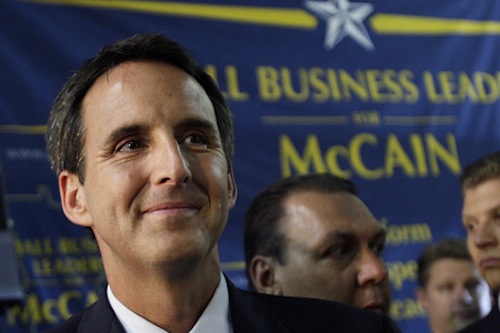Former Minnesota governor, Republican presidential candidate and benevolent eagle Tim Pawlenty delivered what his aides described as a “major economic policy address” yesterday, laying out his plan for the United States economy to achieve 5% annual growth. “Plan,” in this context, is more like “demand,” and “achieve” is “develop with no discernible causality.” The details of Tim Pawlenty’s economic plan may surprise you, particularly if you’ve never heard or read anything about a Republican politician since 1928. The rest of you can put on your disappointed-not-to-be-surprised faces in preparation for the jump.
Pawlenty’s plan has four main elements:
1) reduce corporate income tax rates to 15% from the current 35%,
2) simplify the tax code to only two rates—10% for the first $50,000 of income and 25% for income above that—and eliminate capital gains tax,
3) sell the post office to Al-Qaeda and use the money to locate a genie who will let us wish for more wishes, and
4) balance the budget,
…with one of those elements being made up by me. Another seems to have been made up by Tim Pawlenty, who has not explained how dramatically reducing the revenue of the federal government will eliminate the federal deficit undermining our economy. But that’s all detail stuff; probably, there’s several hundred billion dollars of waste or fraud or something in there that he can save by, you know, catching it. Goddamn federal government pays $400 for a screwdriver anyway.
What Pawlenty’s plan lacks in detail and causality it makes up in rhetoric. During the address, T-Paw called the President a “champion practitioner of class warfare,”* accusing him of turning Americans’ natural love of the very wealthy to resentment in order to divert attention from his policy failures. Pawlenty is guilty of no such obfuscation. His attitude toward specific income brackets doesn’t distract from his economic policy; it is his economic policy, as a quick examination of current US tax rates and income distribution reveals.
accusing him of turning Americans’ natural love of the very wealthy to resentment in order to divert attention from his policy failures. Pawlenty is guilty of no such obfuscation. His attitude toward specific income brackets doesn’t distract from his economic policy; it is his economic policy, as a quick examination of current US tax rates and income distribution reveals.
The adoption of Pawlenty’s two-tiered income tax plan would mean different things to different Americans. For the approximately 12% of households making less than $12,000 a year, everything would stay the same: they would still be poor, and they would still be taxed at 10%, although the elimination of various deductions would likely mean they paid a little more. The 43% of households making between twelve and fifty grand would get a 5% rate cut—from 15% to 10%. That sounds great until you compare it to, say, the 1.5% of households making north of a quarter million each year.
Under Pawlenty’s plan, their income tax rate would drop from 35% to 25%. The plan offers a substantial tax break to every household making more than $117,000, in fact; the richest 15% of the country would see drops in their marginal rates ranging from 3 to 10 points, plus a complete zeroing of capital gains taxes on their investment income. Given the concomitant reduction in taxes on corporations, that bonus will likely be sizable. It’s a lot of numbers, but Pawlenty’s economic plan basically comes down to no tax cuts for the poorest households, a significant tax cut for the sizable middle class, and a cut that ranges from okay to completely awesome for the richest sixth.
Oh yeah—also a massive reduction in federal income. Long-term, Pawlenty says, that loss will be offset by substantial economic growth. Here is our 5% growth rate—a number the former governor seems to arrived at by thinking of the various numbers. Short-term, he’ll balance the budget by cutting spending on government programs. Exactly what those programs will be went unspecified, but Pawlenty advocated something he called “the Google test.”
“If you can find a good or service on the Internet, then the federal government probably doesn’t need to be doing it,” he said. Let’s hope you can find food stamps on the internet, because the Pawlenty plan combines tax cuts for the rich with a dramatic reduction of government services in a system that’s great for investors and business owners and terrible for poor people. At least he’s not engaged in class warfare.
What’s depressing about Pawlenty’s plan is not the naked hypocrisy of his rhetoric, though. It’s his willingness to present as new the exact same economic policy that Republicans have been advocating since Laffer—arguably, since the onset of the Great Depression. Cutting taxes stimulates the economy, even if you have to reduce federal spending to do it, say Republicans from Hoover to Reagan to Pawlenty. In the eight decades since they accepted this theory as gospel truth, its advocates have amassed exactly zero evidence to support it. Yet they stick, in part because one aspect of the argument is absolutely irrefutable: cutting taxes on the rich is good for the rich. If you think the GOP’s client base has expanded much since Roosevelt, you’re mistaken. All they’ve done is gotten a lot more money.





This is a fantastic post.
I wish more people would start using your special names for Republican, hucksters. There’s something about Say-pay, T-paw, and Mm-bach that seems to fit Palin, Pawlenty, and Bachman better than the names their parents gave them.
I could see this being one of the Popular articles on theatlantic.